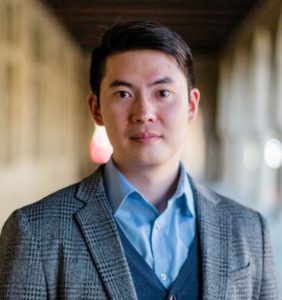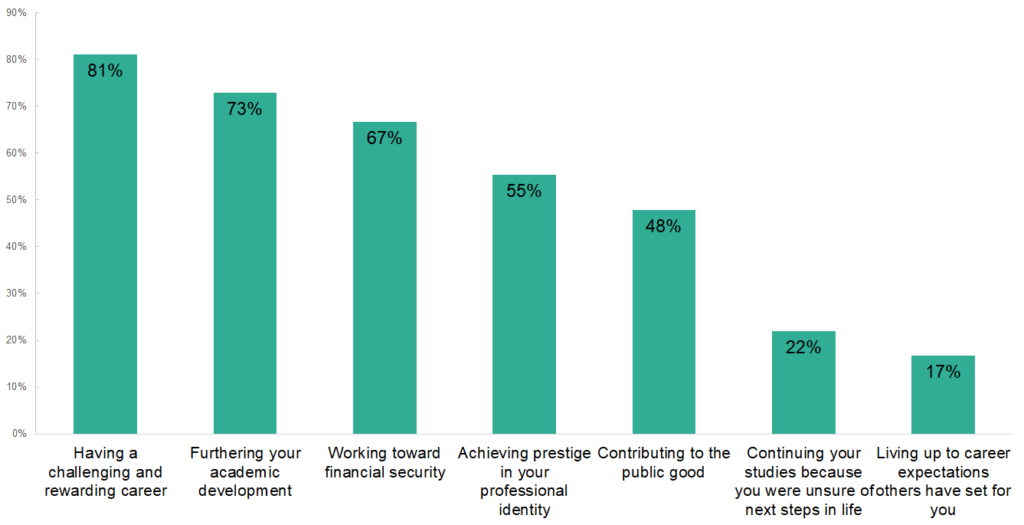
Stephen Daniels
Senior Research Professor
American Bar Foundation

Shih-Chun Chien
Research Social Scientist
American Bar Foundation
The upheaval caused by COVID-19 pandemic might change everything we know about legal education. Reports in the legal media have speculated on the impact of COVID-19 on law school applications, enrollments, budgets and, ultimately, even survival. Depending on the timing, that speculation can run from the negative to the somewhat hopefully positive.[1] Some of the uncertainty comes from the disruption in the normal application to enrollment process – like the cancellation of in-person LSAT testing. More broadly, it surely comes from the truly unprecedented situation in which we find ourselves.
The uncertainty provides an opportunity – in fact, it may require us – to think critically about the homogenized aggregate numbers of applicants and matriculants we often see along with the broad environmental factors said to drive them. With just a few notable exceptions, most recently the 2017 AALS/Gallup surveys,[2] one is tempted to agree with the statement made almost a lifetime ago, “Vague notions, old myths, and thought-shrugging generalities are all we have to describe the raw material from which our lawyers come.”[3]
We need to think systematically about the variety of individual motivations or reasons that may help us understand those prized numbers. This means going beyond the following common idea that appeared recently:
[W]e could also be looking forward to another onslaught of law school applicants thanks to the economic downturn that’s been caused by the pandemic, just like what happened with the recession. ‘In the short-term, going to professional school – be it business school, law school or something else – is a good idea because it’s a refuge from an inhospitable job market, and the job market will be better three years from now.’[4]
An “escapist” explanation like this one is an old one,[5] but its vintage does nothing for its veracity or usefulness.
Such explanations strip any real substance out of the idea of motivation, telling us little about the decision to attend law school and nothing meaningful about the choice of law as a career – and ultimately, this is the important issue. The same is true for explanations that look for environmental causes not escapist in character. A recent variant not tied to escapism is the so-called “Trump Bump.” Here it is the idea that opposition to President Trump – and the overall results of the 2016 election – drove more people to law school than would have been expected. In fact, there may not have been much to it. The bump may have been as much a matter of marginal increases and wishful thinking as anything meaningful. It too is a motivation without real substance if we’re talking about the choice of a life-time career as a professional.[6]
What should we make of a profession that, apparently, is made up of people choosing it for short-term reasons of escape or narrow, time-specific political reasons? Or maybe law school is something akin to Marine Corps training that fundamentally changes the varied lives of the recruits into a singular entity with a distinct mission.
Understanding the motivations that underlie aggregate figures is important for two central reasons in addition to any others. The most immediate and most obvious is enrollment. Law schools must have enough students and the accompanying tuition dollars to keep the doors open. All else of importance depends on this and at some points in time the need for students is more urgent. An article reporting on some of the 2017 Gallup/AALS findings opened by noting the sharp decline in after 2010 in the numbers of people interested in law school and saying that “legal education leaders were posing questions that simply could not be answered definitively: Why is this happening? When will it end? Can we do anything to stop it? … What motivates undergraduates to attend law school or deters them from attending?”[7] Important as these questions are, they are just a beginning.
The more far-reaching reason goes to the role of law schools as the gatekeepers to the profession.[8] They are key in shaping what the profession will look like, what it will be, and even what it will do. Law schools do so through the curriculum, pedagogy and the socialization process – and they do it with the people who choose to attend. Paying attention to general factors in the environment without a good sense of the varying motivations involved in the decision to attend law school is insufficient for performing that role well. That is, unless one is prepared to think those variations – the why, the who, and the interaction of the two – are irrelevant. That the substance of the raw material – beyond LSAT scores and GPAs – is irrelevant so long as the supply chain keeps moving. Literatures in psychology and on organizations suggest that motivations can be important for understanding the outcomes of legal education, especially graduates’ career aspirations. That substance is not irrelevant if we care about the nature of the legal profession and the role it plays or should play in our society.
 In short, motivation should not be simplified to provide just so explanations for law school application or enrollment trends. It is time to look more closely at the variations in and the complexities and dynamic components of motivation. This includes topics like shifts in motivations in response to changing environmental conditions or the possible links between particular variants of motivation and career aspirations or how such inclinations may be changed by the law school experience.
In short, motivation should not be simplified to provide just so explanations for law school application or enrollment trends. It is time to look more closely at the variations in and the complexities and dynamic components of motivation. This includes topics like shifts in motivations in response to changing environmental conditions or the possible links between particular variants of motivation and career aspirations or how such inclinations may be changed by the law school experience.
Some students may just want to join and prosper in the hierarchical legal profession, but others may want to use their legal training and position to change the world. But perhaps more importantly, many may think they want the latter but end up pursuing the former. Do motivations vary depending on one’s characteristics or background? In the deeper past this question may have been easier to address since law students were almost all white and male and from relatively affluent backgrounds, but no so today with a much more diverse student body. What difference, if any, do such changes make?
The earliest motivation studies go back to the 1960s and 1970s,[9] when the legal education landscape looked very different than today. There were fewer law schools but depending on the year chosen for comparison not necessarily fewer students than today and a decidedly non-diverse student body. This means many of their findings may not be all that relevant now, but some are (and that’s a topic for another post).
Perhaps most importantly, the early motivation studies set the stage for later ones even if they did not literally use the same survey questions. All studies, from two 1961 NORC surveys to the 2017 AALS/Gallup surveys,[10] share an interest in a small but varied set of themes surrounding: making money; prestige and professional advancement; serving the public good; the influence of others, especially family; the intellectual side of the profession; independence; and a catch-all category for those with no substantive motivation like waiting out the poor job prospects in sluggish economy. All find that individuals have a mixture of motivations – some more intrinsic, others more extrinsic – with different degrees of importance or intensity.[11] There are some basic consistencies – money and prestige are always important; yet, so are motivations that speak to the public good and to the kind of career wanted. The picture is a nuanced one.
The extant studies, old and more recent, share something else. In addition to asking about motivation they also asked students a host of demographic questions about the students themselves and their family backgrounds. They remind us that the pool of people considering a career in law has changed over time and suggest that motivations may vary among the different groups making up that pool and change over time.
One source – a data set rather than a published analysis – went farther in asking law students numerous questions about their legal education and the type of law they would like to practice along with the setting in which they would like to work. It allows us to look for connections among motivations, backgrounds, law school engagement, and most importantly what a student hopes to do. Motivations become intelligible and meaningful to the extent they are connected to what students – with different backgrounds – hope to do and how well their law schools meet their expectations.
That source is a group of questions included in the 2010 LSSSE survey of law school students. In addition to the broad set of questions asked in the annual LSSSE surveys the 2010 survey asked students at 22 law schools to rate the level of influence of seven possible reasons for choosing to attend law school (reasons readily recognizably in light of earlier studies). From those schools 4,626 responded. Among other things, the survey found that among first year students, the most influential factor in the decision to enter law school was the desire to have a challenging and rewarding career (figure 1). The survey also found a relationship between student motivation and academic engagement.
Figure 1: Percentage of 1Ls who rate each factor “highly influential” in their decision to attend law school (rated 6 or 7 on a seven-point scale)

The 2010 LSSSE is important for another reason. It provides a fascinating snapshot at a critical moment in the contemporary history of legal education: the peak of greatest enrollment, immediately after which came the “great enrollment decline.” The 3Ls in the survey would have made their choice before the Great Recession hit and the 1Ls would have made their choice at a time when the recession was well underway. How might motivations and other student characteristics have differed between these two cohorts – one choosing in better times and the other in worse times?
By 2015 the decline ended and enrollments leveled-off – but at numbers not seen since the 1970s. Students starting this fall will have made their choice as the COVID-19 pandemic – along with its collateral damage – was unfolding, and 2020-21 3Ls would have made their choice in 2018, amidst a robust economy. Are the motivations different? Are the students different?
More interestingly, what would we find if we asked the exact same questions in the spring 2021 LSSSE survey as asked in the spring 2010 LSSSE survey?[12] Are motivations different in this changed world compared to those found in the 2010 data? Are the students different?
While we are working now with the 2010 data to address some of the questions above, we are also working with the LSSSE administrators to include those questions in the upcoming 2021 LSSSE survey. This will allow us to address not only differences at two points in time but changes in motivations, students, and students’ views of their legal educations. Doing so will help provide a fuller understanding of what may underlie students’ reasons to choose law as a career and how well law schools meet those motivations.
__
[1] Staci Zaretsky, “Should Law Schools Be Expecting Another Onslaught of Applicants Thanks to the Pandemic?” Above the Law, April 24, 2020, https://abovethelaw.com/2020/04/should-law-schools-be-expecting-another-onslaught-of-applicants-thanks-to-the-pandemic/; Karen Sloan, “Law School Applications are Down: Will COVID 19 Spur a Late Comeback?” Above the Law, June 3, 2020, https://www.law.com/2020/06/03/law-school-applications-are-down-will-covid-19-spur-a-late-comeback/ : Karen Sloan, “Law Schools See Late Application Boost After Spring COVID 19 Slowdown,” July 14, 2020, https://www.law.com/2020/07/14/law-schools-see-late-applicant-boost-after-spring-covid-19-slowdown/.
[2] See Association of American Law Schools and Gallup, Before the JD: Undergraduate Views on Law School (2018); American Association of Law Schools, LSAC and Gallup, Beyond the Bachelor’s: Undergraduate Perspectives on Graduate and Professional Degrees (2018); Jeff Allum and Katie Kempner, “Inside the Minds of Future Law School Grads: Some Findings from Before the JD,” 87 The Bar Examiner (Winter 2018-1019), https://thebarexaminer.org/article/winter-2018-2019/inside-the-minds-of-future-law-school-grads-some-findings-from-before-the-jd/.
[3] Louis Toepfer, “Introduction,” in Seymour Warkov and Joseph Zelan, Lawyers in the Making (1965); at xv.
[4] Zaretsky, supra note 1, quoting Bernie Burke; see also Sarah Zaretsky, “Law School Applications on the Rise Thanks to Bad Job Market: Law Schools Will Happily Take Applicants’ COVID cash,” Above the Law, July 14, 2020, https://abovethelaw.com/2020/07/law-school-applications-on-the-rise-thanks-to-bad-job-market/.
[5] On escapism, see Barry Boyer and Roger Cramton, “American Legal Education: An Agenda for Research and Reform,” 59 Cornell Law Review 221, 253 (1974); Robert Stevens, “Law Schools and Law Student,” 59 Virginia Law Review 551, 616 (1973).
[6] Stephanie Francis Ward, “The ‘Trump Bump’ for Law School Applicants is Real and Significant, Study Says,” ABA Journal, February 22, 2018, https://www.abajournal.com/news/article/the_trump_bump_for_law_school_applicants_is_real_and_significant_survey_say; Karen Sloan, “Forget the ‘Trump Bump:’ First-Year Law School Enrollment Dipped in 2019,” December 12, 2019, Law.Com, https://www.law.com/2019/12/12/forget-the-trump-bump-law-school-enrollment-dipped-a-bit-in-2019/.
[7] Allum and Kempner, supra note 2.
[8] See Boyer and Cramton, supra note 5, at 224.
[9] See Warkov and Zelan, supra note 3; Leonard Baird, et al., The Graduates: A Report on the Characteristics and Plans of College Seniors (1973); Stevens, supra note 5.
[10] See Warkov and Zelan, id; AALS/Gallup, Before the JD, supra note 2.
[11] Intrinsic motivation refers to the desire to expend effort based on interest in and enjoyment of the task or effort itself – like a motivation driven by the intellectual side of things. In contrast, extrinsic motivation refers to the desire to conduct certain activities to obtain outcomes external to the task or effort itself, such as rewards or recognition – like money or prestige.
[12] See Benjamin Page and Robert Shapiro, The Rational Public: Fifty Years of Trends in Americans’ Policy Preferences (1992), 39: “question wording matters … The only safe way to identify opinion change, then, is compare answers to identical survey questions.” (emphasis in the original)
